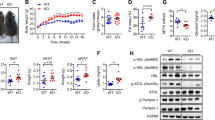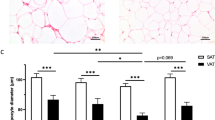Abstract
Objective:
The purpose of this study was to determine the relative distribution of omentin and visfatin mRNA in human epicardial, peri-internal mammary, upper thoracic, upper abdominal and leg vein subcutaneous adipose tissue as well as the distribution of omentin in the nonfat cells and adipocytes of human omental adipose tissue.
Background:
Omentin is found in human omentum but not subcutaneous fat. Omentin and visfatin are considered markers of visceral abdominal fat.
Research design and methods:
The mRNA content of omentin and visfatin was measured by qRT-PCR analysis of fat samples removed from humans undergoing cardiac or bariatric surgery.
Results:
Omentin mRNA in internal mammary fat was 3.5%, that in the upper thoracic subcutaneous fat was 4.7% while that in the other subcutaneous fat depots was less than 1% of omentin in epicardial fat. The distribution of visfatin mRNA did not vary between the five depots. Omentin mRNA was preferentially expressed in the nonfat cells of omental adipose tissue since the omentin mRNA content of isolated adipocytes was 9% of that in nonfat cells, and similar results were seen for visfatin. The amount of omentin mRNA in differentiated adipocytes was 0.3% and that of visfatin 4% of that in nonfat cells. The amount of omentin mRNA in preadipocytes was virtually undetectable while that of visfatin was 3% of that in freshly isolated nonfat cells from omental adipose tissue.
Conclusion:
Omentin mRNA is predominantly found in epicardial and omental human fat whereas visfatin mRNA is found to the same extent in epicardial, subcutaneous and omental fat.
This is a preview of subscription content, access via your institution
Access options
Subscribe to this journal
Receive 12 print issues and online access
$259.00 per year
only $21.58 per issue
Buy this article
- Purchase on Springer Link
- Instant access to full article PDF
Prices may be subject to local taxes which are calculated during checkout


Similar content being viewed by others
References
Komiya T, Tanigawa Y, Hirohashi S . Cloning the novel gene intelectin, which is expressed in intestinal Paneth cells in mice. Biochem Biophys Res Commun 1998; 251: 759–762.
Tsuji S, Uehori J, Matsumoto M, Suzuki Y, Matsuhisa A, Toyoshima K et al. Human intelectin is a novel soluble lectin that recognizes galactofuranose in carbohydrate chains of bacterial cell wall. J Biol Chem 2001; 276: 23456–23463.
Wrackmeyer U, Hansen GH, Seya T, Danielsen EM . Intelectin: a novel lipid-raft-associated protein in the enterocyte brush border. Biochemistry 2006; 45: 9188–9197.
Lee JK, Schnee J, Pang M, Wolfert M, Baum LG, Moremen KW et al. Human homologs of the Xenopus oocyte cortical granule lectin XL35. Glycobiology 2001; 11: 65–73.
Yang RZ, Lee MJ, Hu H, Pray J, Wu HB, Hansen BC et al. Identification of omentin as a novel depot-specific adipokine in human adipose tissue: possible role in modulating insulin action. Am J Physiol Endocrinol Metab 2006; 290: E1253–E1261.
Schaffler A, Neumeier M, Herfarth H, Furst A, Scholmerich J, Buchler C . Genomic structure of human omentin, a new adipocytokine expressed in omental adipose tissue. Biochim Biophys Acta 2005; 1732: 96–102.
Wurm S, Neumeier M, Weigert J, Schaffler A, Buechler C . Plasma levels of leptin, omentin, collagenous repeat-containing sequence of 26-kDa protein (CORS-26) and adiponectin before and after oral glucose in slim adults. Cardiovasc Diabetol 2007; 6: 7 doi:10.1186/1475-2840-6-7.
de Souza Batista CM, Yang RZ, Lee MJ, Glynn NM, Yu DZ, Pray J et al. Omentin plasma levels and gene expression are decreased in obesity. Diabetes 2007; 56: 1655–1661.
Fain JN . Release of interleukins and other inflammatory cytokines by human adipose tissue is enhanced in obesity and primarily due to the nonfat cells. Vitam Horm 2006; 74: 443–477.
Trujillo ME, Scherer PE . Adiponectin—journey from an adipocyte secretory protein to biomarker of the metabolic syndrome. J Intern Med 2005; 257: 167–175.
Ho E, Shimada Y . Formation of the epicardium studied with the scanning electron microscope. Dev Biol 1978; 66: 579–585.
Fukuhara A, Matsuda M, Nishizawa M, Segawa K, Tanaka M, Kishimoto K et al. Visfatin: a protein secreted by visceral fat that mimics the effects of insulin. Science 2005; 307: 426–430.
Grundy SM, Cleeman JI, Daniels SR, Donato KA, Eckel RH, Franklin BA et al. Diagnosis and management of the metabolic syndrome: an American Heart Association/National Heart, Lung, and Blood Institute scientific statement executive summary. Circulation 2005; 112: 2735–2752.
Genuth S, Alberti KG, Bennett P, Buse J, Defronzo R, Kahn R et al. Follow-up report on the diagnosis of diabetes mellitus. Diabetes Care 2003; 26: 3160–3167.
Halvorsen YD, Bond A, Sen A, Franklin DM, Lea-Currie YR, Sujkowski D et al. Thiazolidinediones and glucocorticoids synergistically induce differentiation of human adipose tissue stromal cells: biochemical, cellular and molecular analysis. Metabolism 2001; 50: 407–413.
Fain JN, Tichansky DS, Madan AK . Most of the interleukin 1 receptor antagonist, cathepsin S, macrophage migration inhibitory factor, nerve growth factor, and interleukin 18 release by explants of human adipose tissue is by the non-fat cells, not by the adipocytes. Metabolism 2006; 55: 1113–1121.
Chomczynski P, Sacchi N . Single-step method of RNA isolation by acid guanidinium thiocyanate-phenol-chloroform extraction. Anal Biochem 1987; 162: 156–159.
Tan BK, Chen J, Digby JE, Keay SD, Kennedy CR, Randeva HS . Increased visfatin messenger ribonucleic acid and protein levels in adipose tissue and adipocytes in women with polycystic ovary syndrome: parallel increase in plasma visfatin. J Clin Endocrinol Metab 2006; 91: 5022–5028.
Berndt J, Kloting N, Kralisch S, Kovacs P, Fasshauer M, Schon MR et al. Plasma visfatin concentrations and fat depot-specific mRNA expression in humans. Diabetes 2005; 54: 2911–2916.
Cheng KH, Chu C-S, Lee KT, Lin TH, Hsieh CC, Chiu CC et al. Adipocytokines and proinflammatory mediators from abdominal and epicardial adipose tissue in patients with coronary artery disease. Int J Obesity 2007 (in press).
Mazurek T, Zhang L, Zalewski A, Mannion JD, Diehl JT, Arafat H et al. Human epicardial adipose tissue is a source of inflammatory mediators. Circulation 2003; 108: 2460–2466.
Thong FS, Bilan PJ, Klip A . The Rab GTPase-activating protein AS160 integrates Akt, protein kinase C, and AMP-activated protein kinase signals regulating GLUT4 traffic. Diabetes 2007; 56: 414–423.
Montagnani M, Ravichandran LV, Chen H, Esposito DL, Quon MJ . Insulin-receptor substrate-1 and phosphoinositide-dependent kinase-1 are require for insulin-stimulated production of nitric oxide in endothelial cells. Mol Endocrinol 2002; 16: 1931–1942.
Kawashima S, Yokoyama M . Dysfunction of endothelial nitric oxide synthase and atherosclerosis. Arterioscler Thromb Vasc Biol 2004; 24: 998–1005.
Sacks HS, Fain JN . Human epicardial adipose tissue. A review. Am Heart J 2007; 153: 907–917.
Moore KL, Persaud TVN . The developing human. Clinically Oriented Embryology, 7th edn. W.W. Saunders Co.: Philadelphia, PA, USA, 2003. p 189.
Damgaard S, Steinbruchel DA, Kjaergard HK . An update on internal mammary artery grafting for coronary artery disease. Curr Opin Cardiol 2005; 20: 521–524.
Acknowledgements
The Van Vleet Chair of Excellence, University of Tennessee and the Baptist Heart Institute and Foundation, Memphis supported this study. We thank Pammi Cheema for her skilled technical assistance in carrying out these studies, Dr Bill Taylor and the staff of the Molecular Resource Center of UT for access to and assistance with the Roche LightCycler 480 real-time PCR system, the Clinical Research Center staff of Baptist Hospital and to James Karas MS for assisting with statistical analysis. This study was supported by grants from The Van Vleet Chair of Excellence, University of Tennessee and the Baptist Heart Institute and Foundation, Memphis.
Author information
Authors and Affiliations
Corresponding author
Rights and permissions
About this article
Cite this article
Fain, J., Sacks, H., Buehrer, B. et al. Identification of omentin mRNA in human epicardial adipose tissue: comparison to omentin in subcutaneous, internal mammary artery periadventitial and visceral abdominal depots. Int J Obes 32, 810–815 (2008). https://doi.org/10.1038/sj.ijo.0803790
Received:
Revised:
Accepted:
Published:
Issue Date:
DOI: https://doi.org/10.1038/sj.ijo.0803790
Keywords
This article is cited by
-
Plasma level of omentin-1, its expression, and its regulation by gonadotropin-releasing hormone and gonadotropins in porcine anterior pituitary cells
Scientific Reports (2023)
-
The effect of ITLN1, XCL2 and DOT1L variants on knee osteoarthritis risk in the Han population
Archives of Orthopaedic and Trauma Surgery (2023)
-
Cardiac Adipose Tissue Contributes to Cardiac Repair: a Review
Stem Cell Reviews and Reports (2021)
-
Maternal omentin-1 level, quality of life and marital satisfaction in relation to mode of delivery: a prospective cohort study
BMC Pregnancy and Childbirth (2020)
-
Epicardial fat tissue in patients with diabetes mellitus: a systematic review and meta-analysis
Cardiovascular Diabetology (2019)



